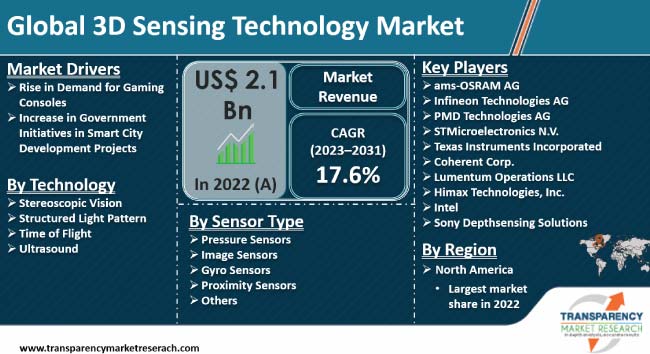New Report – 3D Sensing Technology Market 2026Posted by surendra choudhary on January 28th, 2020  The global 3D sensing technology market was valued at US$ 831.1 Mn in 2016 and is projected to register compound annual growth rate (CAGR) of over 19.16% from 2018 to 2026, according to a new report published by Transparency Market Research (TMR) titled “3D Sensing Technology Market – Global Industry Analysis, Size, Share, Growth, Trends, and Forecast, 2018–2026.” The report suggests that rising use of 3D sensing technology across automotive, consumer electronics, and media & entertainment industries worldwide along with the rising trend of using technology such as augmented reality or virtual reality around the globe is likely to spur the demand for 3D sensing technology in the coming years. As key players introduced 3D sensing technology in developed markets such as North America, Europe, and Asia Pacific, these regions are likely to account for dominant share of the global 3D sensing technology market. Growing demand for 3D sensing technology from next generation smartphones in emerging markets such as China, Japan, and India is likely to boost growth of the Asia Pacific 3D sensing technology market at a growth rate of around 18% from 2018 to 2026. For More Details, Request A PDF Sample Report @ https://www.transparencymarketresearch.com/sample/sample.php?flag=S&rep_id=39959 Heavy maintenance cost of 3D sensing technology related components and devices to affect the expansion of 3D sensing technology worldwide Application of 3D sensor technology is expected to expand across multiple industry verticalssuch as consumer electronics, media & entertainment, automotive, and security & surveillance, providing novel opportunities in the field of 3D sensing technology. However, some restraints can have a negative impact on the growth ofthe 3D sensing technology market. 3D sensor has high cost of maintenance due to the complex circuits used in the VCSEL (Vertical-cavity surface-emitting laser) technology.This could be a major factor that could hamper the growth of the 3D sensing technology market. However, many manufacturers are planning to increase the production of 3D sensors due to continuously growing demand, which could overcome this restraint in the near future. Demand for 3D sensing technology is continuously increasing across many industry verticals globally Many industry verticals including automotive, consumer electronics, and security & surveillance among others are using 3D sensing technology for development. Across the automotive vertical, 3D sensing technology is extremely useful because it helps in monitoring the movement of the driver’s eyesto identify tiredness to enhance safety. Furthermore, it also helpsthe driver to modify the airbags or seats of the vehicle automatically based on requirement. In case of industrial robotics, 3D sensing technology helps in controlling the movement of robots through gesture recognition and also helps in preventing collision between them inside a factory. Additionally, 3D sensing technology is heavily adopted across the consumer electronics industry, as it creates novel opportunities for facial recognition, virtual reality, augmented reality, and motion detection. North America is the leading contributor to the 3D sensing technology In terms of value, North America was the leading contributor to the global 3D sensing technology market in 2017. The contribution is primarily due to the booming 3D sensing technology marketplace along with the presence of well-established players across the region, especially driven by the U.S. and Canada. The U.S. is home to many well-established players from the 3D sensing technology domain including Texas Instruments Incorporated, Intel Corporation, Finisar Corporation, and Lumentum Holdings Inc. Furthermore, North America is witnessing higher adoption of 3D sensing technology due to higher investment in the R&D of innovative 3D sensing technology related components and devices by these well-established players. Many companies are collaborating with other players to enhance the capability of 3D sensing technology. For instance, in 2015, Intel Corporation partnered with TowerJazz (a global specialty foundry company) for mass production of an IR sensor used by Intel Corporation in its 3D sensing solutions. Intel chose TowerJazz's CMOS image sensor platform as it provides prominent pixel performance at near infrared light with high speed and optical resolution. Key Players such as AMSAG, II-VI Incorporated, Intel Corporation, and Lumentum Holdings Inc. likely to lead the global 3D sensing technology market AMSAG, II-VI Incorporated, Intel Corporation, and Lumentum Holdings Inc.among others are some of the major players in the 3D sensing technology market profiled in this study. Various players are focusing on novel 3D sensing technology related products for a wide variety of applications. For instance, in March 2018, II-VI Incorporated announced a novel emitting distributed feedback (DFB) laser diode for a range of applications pertaining to 3D sensing technology. The product emits power greater than 500 mW and helps consumer devices in digitally reconstructing the surrounding scenes in 3D with the help of reflected laser light. Like it? Share it!More by this author |


